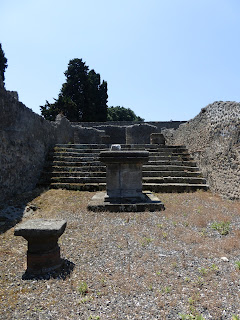 |
| This is the beautiful coast town of Sorrento. (Photo: Wikipedia) |
I highly doubt that any words can describe the ancient ruins, so it is once again slideshow time.
 |
| The steel structures here are from the present day, but the rest of this huge amphitheater was built in the 2nd century BC. That's quite impressive for such an ancient civilization. |
 |
| These "town homes" used to be two stories tall before the eruption. |
 |
| This area was the temple of Asclepius, a temple dedicated to the gods Zeus, Hera, and Aphrodite. |
 |
| Even more plaster molds. There was even a mold in the shape of a small child... well, that's horrifying. I took one look at that and thought "well, that's enough Pompeii for today." |
 |
| Perhaps the largest structure in the city, the ruins of a coliseum. |
We also visited Vesuvius, despite the fact that it is still classified as an active volcano and is long overdue for an eruption based on its past schedule. I know that sounds pretty stupid of us, considering that it is the volcano that destroyed an entire city and covered it in piping hot ash (and a pretty far away city at that), but luckily, the volcano hasn't erupted since 1944.
 |
| Vesuvius from a distance. |
 |
| An up-close view into the heart of the volcano. |
 |
| Ditto. It doesn't look very dangerous, despite being legendary for its violent eruption. |
That's all for today. Tune in tomorrow for a story about Positano, one of the most unlikely cities on the planet.
Also, I'm starting a new segment at the end of each post- a Greek mythology lesson! I was inspired by the multiple Greek temples at Pompeii, so over the course of this vacation I'll be sharing my knowledge on the gods with everyone who cares to know it.
Thanks for reading!
Aidan's Greek Gods
Chapter 1: In the beginning
In the beginning, there were only two beings in existence- the Earth, Gaea (say GI-a) and the sky, Uranus. Understandably, they had children, since there wasn't really anyone or anything else with which to do so. These first children were the cyclopes (plural of cyclops). They were strong and were excellent blacksmiths, but Uranus was disgusted by them, possibly due to each one only having one, grotesque eye. Uranus cast the cyclopes into Tartarus, the deepest pit in existence, much to the chagrin of Gaea.
Still, the two had more children... and yet, the sky saw these as being even worse. They were the hundred-handers, monstrous beings who were as tall as mountains and possessed one hundred arms each. These, too were banished to the depths of Tartarus.
Finally, Gaea and Uranus tried one more time. This time, the resulting beings were the Titans.
Will the Titans earn Uranus's approval? Will new life inhabit the planet at last? Tune in next time for more!



No comments:
Post a Comment